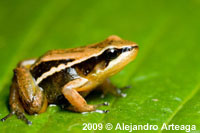Scientists discover Andean poison dart frog believed extinct since 1995
 Hyloxalus anthracinus
Hyloxalus anthracinusCuenca, Ecuador (23 September 2009) – Fundación Cordillera Tropical announces that during a recent inventory scientists discovered a high-altitude Andean poison dart frog, believed to have been extinct, in southern Sangay National Park, Ecuador. Alejandro Arteaga, a biology student at the Catholic University of Quito, recorded an individual of the species Hyloxalus anthracinus (common name Andean poison dart frog or high altitude rocket frog) during a recent inventory of reptiles and amphibians. According to Eduardo Toral and Manuel Morales, biologists at the Catholic University of Quito, this species was last recorded on June 11, 1995, in the Mazan Protected Forest of Cajas National Park. This and other frog species have experienced population declines in recent years, which scientists believe is principally due to habitat loss and the spread of an amphibian fungal disease known as quitridiomicosis.
Arteaga's inventory took place in June and July 2009 and was directed by Stuart White, General Coordinator of FCT. Arteaga recorded nine frog species in total, primarily of the genus Pristimantis ("robber frog"). This diversity, and the rediscovery of H. anthracinus, is not that surprising. White notes that in 2002, biologists from the Catholic University of Quito discovered two species of frogs new to science in the same area. As White puts it, "The eastern cloud forests of Sangay National Park harbor an impressive variety of species: spectacled bear, puma, margay, mountain tapir, Andean wax-palm, giant Podocarpus trees, and now this high altitude rocket frog, all of which are threatened to some degree. This combination of biodiversity and vulnerability begs further research and greater conservation efforts."
H. anthracinus was rare even before scientists believed it extinct; until now the specieshas been reported in only six areas of Ecuador, including the Mazan Protected Forest, at altitudes between 2710-3500m. Arteaga's is the first registered sighting of the frog in the southern zone of Sangay National Park, a protected area of more than 502,000 hectares located in the Ecuadorian provinces of Tungurahua, Chimborazo, Cañar, and Morona Santiago. In spite of its recent rediscovery, H. anthracinus will continue to be listed as "Critically Threatened" according to the Red List of Amphibians of Ecuador.
The Tropical Andes, including the forests and páramos of Sangay National Park, are said to harbor the greatest frog diversity in the world. Among other distinctions, this fact gives rise to the region's designation as a biodiversity "hotspot": an area of the planet with high biodiversity that is also threatened with the loss of at least 70% of its native vegetation. In the Tropical Andes alone, for example, there are 363 threatened amphibian species. Such habitat loss is one of the main factors in the worldwide population decline of many animal species.
The Ecuadorian Andes, despite their location in the Tropical Andes hotspot, are poorly studied. The paucity of wildlife studies conducted in this region was what prompted the species inventory conducted by Arteaga and FCT. As Catherine Schloegel, biologist and Executive Director of FCT, summarizes, "There have been significant declines in frog populations in tropical montane zones ever since 1980. This discovery is very important because it establishes the presence of Hyloxalus anthracinus in the eastern montane forest, and underlines the importance of conducting further studies in the area to ensure conservation of this and other species."
